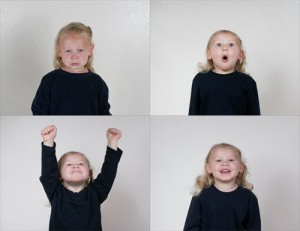
At what age do infants come to perceive and understand the “grown-up” emotional spectrum? This is the question a group of BYU scholars aimed to answer.
Ph.D student and lead author Darren Garcia, with associate professor Ross Flom and fellow Ph.D student Rebecca Janis, conducted an experiment with a group of preschoolers to find the answer to this complex question. A total of 144 children ranging from ages 2 to 6 participated in the study.
“What we really wanted to do is understand when kids recognize what we call secondary emotions,” Flom said. “Secondary emotions have a cognitive component, that is, you have to perform some sort of self-evaluation or comparison against a rule that you may have violated. And these, contrary to the basic set of primary emotions of joy, sadness and fear, are much more complex.”
In order to determine how early children develop more intricate emotions, the researchers devised a fabricated game that consisted of beating the world’s fastest builder of block towers.
“Can you beat ‘the fastest tower builder’ of the world?” Garcia said. “The catch? The kids didn’t know that the outcome of the game had already been fixed, and only one group of kids gets to win the game.”
The purpose of the study was to have the winners and the losers choose among four pictures that depicted complex emotional expressions.
“Winners got the ‘Wow, that’s great, you beat him, you won,’ while the unlucky ones got to hear the classic “Oh, you did well, but you lost,” Flom said. “We then presented the kids with a set of pictures depicting another child displaying the secondary emotions of a sense of pride, surprise, sadness and happiness. Lastly, we asked them to point to the picture that best shows how they felt after winning or losing.”
The study found that the children between 2 and 3 years of age were not able to reliably recognize themselves in the four pictures.
“However, if you ask the 4-year-olds to point to the picture that shows pride they will reliably do it,” Flom said. “Finally, the youngest kids couldn’t self-identify pride in another child, but their own behavior conveyed pride.”
One important detail to point out from the study is the fact that even though the youngest kids were unable to recognize pride in another child, their own behavior conveyed pride.
“We had undergraduates watch the videotaped events, and while they couldn’t see whether the child won or lost, they were shown the outcomes,” Flom said. “This was a blind test; we asked, ‘What emotion do you think this child is displaying?’ Pride, happiness, sadness, anger or ‘I don’t see any emotion.'”
The 2-year-olds, while unable to accurately point out the emotions of their situation in other pictures of children, still displayed some noticeable swagger toward their own victory.
“Most of the undergraduates reliably reported that from about 2.5 to three years on up, when the child won, they identified the kid as displaying pride in their behavior and their posture,” Flom said.
Knowing the unknown is what fueled the idea of finding the specifics of secondary emotions in human development.
“While primary emotion studies have been done in the past, we wanted to examine the much less researched area of secondary emotions,” Flom said.
Justin Dyer, associate professor in the family life department, mentioned that this research is crucial to determining the development of a child’s early memories.
“Emotions obviously play a big role in development,” Dyer said. “One point the study brings up is that emotions can facilitate memory building. Not surprisingly, when experiences are coupled with emotion, we remember the experience more clearly. Particularly if the emotion was negative.”
The word “pride” has various connotations, and the study focused solely in the non-hubristic sense of the emotion. For this study, pride explored the areas of a good sense of self-esteem and a motivation to achieve.
“What the study talks about is self-efficacy,” Dyer said. “A person with a high sense of self-efficacy feels that they are able to accomplish goals. In one way, it’s about what the individual could do by themselves; but in a broader sense, it’s about them being able to learn what is necessary or gather the necessary resources in order to accomplish something.”
The researchers concluded that it is important to help children develop a constructive emotional view during their early years and prepare them for success as well as failures.
“I consider that at 4 years of age, it might be worthwhile discussing these cognitively more complex emotions with your children,” Flom said, “so that they can develop an awareness of others’ emotions as well as their own.”




